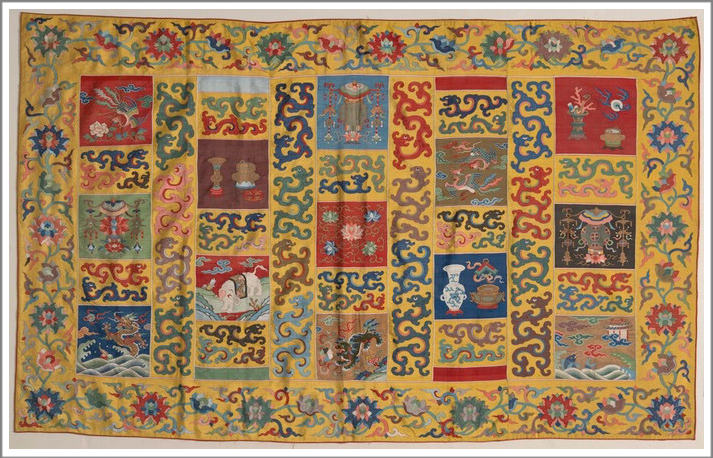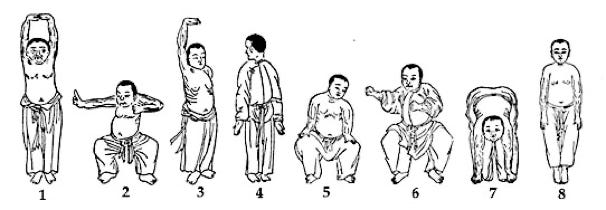This is an overview of the almost-lost Yang-style Taiji Baduanjin (楊式太極拳八段錦) from the Yang-style Taijiquan tradition. These eight extraordinary segments are perfect for those who want to go deep into the internal aspects of taijiquan and, indeed, encapsulated many of the art’s core-principles concepts. This article is also a primer for those interested in an upcoming ZOOM event by the author. At the end of this piece below is a video overview/explanation of the Yang-style Taiji Baduanjin practice.

About the Yang-style Taiji Baduanjin
In an introduction to his 2011 book ‘Yang-style Taiji Real Power’ (Yang-shi Taiji Zhen Gong 楊式太極真功) author Sun Yizhao explains,
“Taiji Baduanjin was originally created by the Yang family as a training method for mobilizing qi and training jin (yùnqì liànjìn gōngfǎ 運氣練勁功法). Like other forms of baduanjin there are eight sections but the movements are not the same. It can be distinguished by it's 'forging and smelting' (duànliàn 鍛煉) of the sections and joints of the body and the strengthening of the internal organs and their way of functioning. It strengthens visceral system functioning and also contains within it a great deal of attack and defence training methods (jiji 技擊).”
“The Yang-style Taijiquan Baduanjin was originally an indoor family neigong of the Yang family—a secret weapon of sorts. It can be seen variously as a good solid warmup and strength and flexibility practice or as an essential piece of the Yang-style Taijiquan curriculum.”
Baduanjin (baduanjin 八段錦) means ‘eight-section brocade’ and connotes the side-by-side placement of different weaves of fabric seen, for example, in the robes of Emperors or monks.
The term baduanjin first appears in Hong Mai’s ‘Records of the Listener’ in the Song Dynasty (1127-1279). The Emperor’s Chief Secretary Li Siju is described as living a simple life which includes getting up at night to practice deep breathing, self massage, and exercises called baduanjin. Today a standard set of baduanjin is practiced and is readily found in books and on the internet.
The Yang-style Taijiquan Baduanjin is not correlated with the standard sequence. It originates with Yang Jianhou (楊健侯 1839-1917), possibly, in part, from his father Yang Luchan (楊露禪 1799–1872) and was passed to Jianhou disciple Tian Zhaolin (田兆麟 1891-1959). Most practitioners of the Yang-style Taijiquan Baduanjin today descend from the Tian lineage. In the late 1930s, Tian Zhaolin began a collaborative writing project with a martial-arts enthusiast named Chen Yanlin which was later to be published in 1943 as ‘Taiji Boxing, Sabre, Sword, Pole, Sparring Compiled’ (太極拳刀劍桿散手合編), but without Tian’s name attached.

In the book Chen Yanlin devotes an entire chapter to a series of twenty-one neigong exercises called 'Taijiquan Preliminary Strengthening Body and Mobilizing Qi Method' (tàijíquán chūbù jiànshēn yùnqìfǎ 太極拳初步健身運氣法). He warns would-be practitioners not to trivialize it as merely another set of ‘eight-brocades’ qigong. In fact this routine forms a part of the of the Yang Baduanjin, as do several of the single form methods described later in this book. The first English language presentation of this part of Chen’s book can be found in Stuart Alve Olsen’s 1986 book ‘Cultivating the Ch’i.’

Overview of the Yang-style Taijiquan Baduanjin
There is a specific and logical order to the sequence having to do with harmonizing and increasing qi circulation and preparing the practitioner for martial arts practice.
Brocade One: Peng and An (掤按)
Brocade Two: 21 Form Neigong (初步健身運氣法)
Brocade Three: The Waist and Spine (腰脊椎)
Brocade Four: The Arms (胳膊)
Brocade Five: The Legs (腿)
Brocade Six: Zhan Zhuang (站樁)
Brocade Seven: Fajin and Chansijin (發勁纏絲勁)
Brocade Eight: Caituigong (踩腿功)
The first brocade is a general ‘whole-body’ preparation based on alternating between the taijiquan energies peng (掤勁) and an (按勁) in coordination with the movement of awareness, breath and qi along the ‘small circulation’ (xiǎozhōutiān 小周天) path. It involves pushing outward from the centre of the body in six directions following the ancient formula of ‘sink shoulder, drop elbow, sit wrist’ (chén jiān, zhuì zhǒu, zuò wàn 沉肩墜肘坐腕). The purpose of this section is to bring the practitioner into the taijiquan ‘zone’ physically, mentally and energetically by pushing outward (to an) and then releasing (to peng) in a peristaltic fashion. Peng and an are the principle ‘square’ (zhèng 正) energies upon which Yang-style Taijiquan theory is based and are related fundamental practices such as ‘sticking and adhering energy (zhān-nián jìn 粘黏勁) and the issuing of power (fājìn 發勁).
The second brocade is comprised of a sequence of twenty-one exercises that take the extending and contracting features of the first section somewhat further. Better known as a stand alone neigong exercise called 'Taijiquan Preliminary Strengthening Body and Mobilizing Qi Method' (tàijíquán chūbù jiànshēn yùnqìfǎ 太極拳初步健身運氣法), the second section is considered valuable for loosening the sinews (jīn 筋) and opening up the meridians (jīngluò 經絡). At advanced levels of practice, the gestures of this section aid the development of martial energies (jiéjìn 截勁), 'cold energy' (lěngjìn 冷勁). In some versions of the Yang-style Taijiquan Baduanjin this section is sometimes broken into two parts which form sections one and two of the series—the above-described peng and an first section is not practiced in these variations.
The third brocade exercises the waist, spine and central nervous system—the core of the body. This section, broken into three parts, involves; first, localized stretching along the spine, back of the legs and groin; second, ‘seeing’ exercises designed to stimulate the retina; third, ‘the tree,’ a stance exercise that further integrates the waist, spine and central nervous system with the stance. The section ends with a fajin exercise that brings together elements of the first, second and third sections.
The fourth brocade focuses on the arms and is broken into three parts. The first part of the arm section focuses on loosening (fàngsōng 放松) the arms as they move through positions relevant to gestures in taijiquan. The second part includes coordination practices meant to integrate arm and core body movement. The final part of the arms section further exercises peng and an in three ranges and deepens the squatting stance.
The fifth brocade trains the legs in three principal ways. First, the backs of the legs are stretched deeply in order to improve flexibility and increase kicking range. The next part of the leg training regimen involves standing upright on one leg while circling the other in ways that support peng and an and, as well, promote stability for kicking and leg sweeping. The last part of the leg section involves the practice of eight leg methods used in kicking, propping, and sweeping.
The sixth brocade trains the ‘standing-post’ (zhànzhuāng 站樁) via two main methods. The first method is the ‘Horse-stance Post-standing' (mǎbù zhànzhuāng 馬步站樁). The name refers to the resemblance between the open leg squatting and the position of one’s legs when riding on horseback. The second method is the 'River Post-standing’ (chuānzìshì zhànzhuāng 川字式站樁) and trains the 'empty stance (xūbù 虛步). The name evokes a person standing on the bank beside a river and touching the water with the foot of the free leg.
Brocade seven deals with ‘reeling silk energy’ (chánsījìn 纏絲勁) and ‘issuing power’ (fājìn 發勁). Reeling silk, a concept employed for refining and blending neutralizing and attacking powers, is trained using outer and inner ‘whips’ and corresponding ‘thumping’ and ‘piercing’ fajin-striking methods. The last part of this section involves methods of ‘deflect-parry-thump’ (bānlánchuí 搬攔捶).
The eighth and final brocade of the Yang-style Taijiquan Baduanjin integrates many aspects of the sections four through seven via ‘trample-step leg training’ (cǎituǐgōng 踩腿功). Focusing on concepts of square and diagonal energy (sìzhèng 四正 and sìyú 四隅) found in taijiquan’s ‘thirteen-powers’ (shísān shì 十三勢) martial theory this section uses the trample-step leg method (cǎituǐfǎ 採腿法) and the 'wing-leg’ method (chìtuǐfǎ 翅腿法) to develop a highly integrated martial stepping and applications method.









